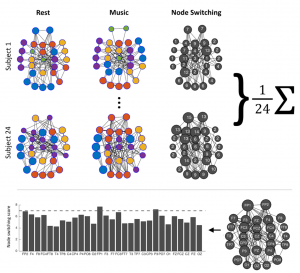-
5
Feb
A new study reports for the first time functional interactions among brain rhythms in music perception using a novel, elegant, multiplex-aware approach based on a community detection algorithm.
- The approach was motivated by recent trends in Network Science that focus on the multi-scaled character of complex network systems.
- A novel, elegant, multiplex-aware framework is introduced, based on a community detection algorithm.
- The findings provide evidence about the functional inter-layer coherence between δ and βH oscillatory rhythms that can be interpreted as increased inter-dependence and hence elevated multiplexing during music listening.
- The methodology includes an efficient graph- partitioning algorithm, which is further utilized for mining prototypical modular patterns, and a novel algorithmic procedure for identifying “switching nodes” (i.e. recording sites) that consistently change module during music listening.
- The framework is efficient and potentially useful in many other studies concerning brain rhythms and their functional role in cognition.
The study is based on an EEG music experiment based on the first part of the Johann Sebastian Bach Violin Concerto No. 1, Allegro moderato in A minor (BWV 1041). The first movement of this concerto features as an excellent example of a fundamental musicological form known as the ritornello form.
The paper is to appear in Journal of Neural Engineering as:
Dimitrios A. Adamos, Nikolaos Laskaris, and Sifis Micheloyannis, Harnessing functional segregation across brain rhythms as a means to detect EEG oscillatory multiplexing during music listening, Journal of Neural Engineering (2018).
A preprint is available through ResearchGate.net
Source codes are available at: https://github.com/AdamosDA/Brain-Rhythms-Multiplexing
For further details see: https://www.linkedin.com/pulse/music-listening-triggers-eeg-brain-rhythms-dimitrios-adamos/
- Published by Dimitrios A. Adamos in: Documentation
- RSS feed subscription!


 Neurobot via RSS
Neurobot via RSS
